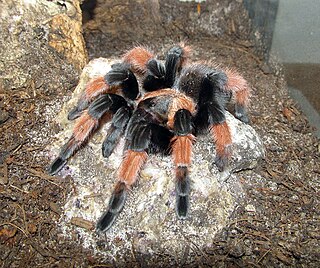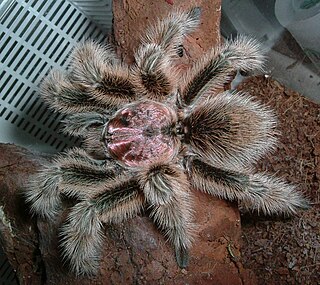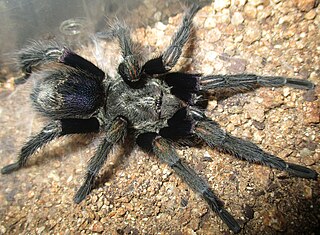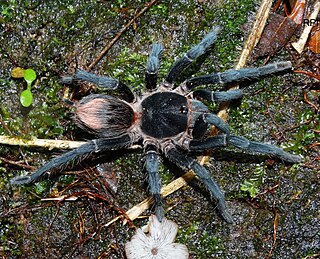
Urticating hairs or urticating bristles are one of the primary defense mechanisms used by numerous plants, almost all New World tarantulas, and various lepidopteran caterpillars. Urtica is Latin for "nettle", and bristles that urticate are characteristic of this type of plant, and many other plants in several families. This term also refers to certain types of barbed bristles that cover the dorsal and posterior surface of a tarantula's or caterpillar's abdomen. Many tarantula species eject bristles from their abdomens, directing them toward potential attackers. These bristles can embed themselves in the other animal's skin or eyes, causing physical irritation, usually to great discomfort. The term "hairs" is technically a misnomer, as only mammals possess true hairs. The scientific term for plant hairs is trichomes.

Brachypelma is a genus of spiders in the family Theraphosidae (tarantulas). They may have bodies up to 6 cm long with legs of similar or greater lengths. Some species have brightly colored legs, with red or orange marks and rings.

Grammostola is a genus of South American tarantulas that was first described in text by Eugène Louis Simon in 1892. These medium- to large-sized spiders are native to tropical South America, and are usually brown in color, with pinkish or orangish-red hairs. The very docile Chilean rose tarantula is popular as a beginner's spider among tarantula enthusiasts.

Euathlus is a genus of South American tarantulas that was first described by Anton Ausserer in 1875. These spiders are medium sized and are usually found in high elevations in the Andes. It is a senior synonym of Paraphysa, and was formerly considered a senior synonym of Brachypelma, but this was later rejected.

Tarantulas comprise a group of large and often hairy spiders of the family Theraphosidae. As of December 2023, 1,100 species have been identified, with 166 genera. The term "tarantula" is usually used to describe members of the family Theraphosidae, although many other members of the same infraorder (Mygalomorphae) are commonly referred to as "tarantulas" or "false tarantulas". Some of the more common species have become popular in the exotic pet trade. Many New World species kept as pets have setae known as urticating hairs that can cause irritation to the skin, and in extreme cases, cause damage to the eyes.

Cyriocosmus is a genus of tarantulas that was first described by Eugène Louis Simon in 1903. They are small to medium spiders, with a bicolored or one same color carapace.

Bumba is a genus of tarantula native to the Americas. It is an uncommon genus, comprising eight known species, including one named after John Lennon. Like most related species in the subfamily Theraphosinae, they may flick urticating hairs in response to threats.
Bumba lennoni is a species of tarantula found in 2015 in Caxiuanã National Forest. It is about one inch long, small for a tarantula but is closely related to the largest spider in the world.
Bistriopelma matuskai is a species of tarantula, in the theraphosinae subfamily, which is only known from Peru.
Tmesiphantes uru is a species of tarantula in the subfamily Theraphosinae. It is endemic to Argentina.
Tmesiphantes is a genus of Brazilian tarantulas in the subfamily Theraphosinae that was first described by Eugène Louis Simon in 1892. The genera Magulla and Melloleitaoina were brought into synonymy in 2019.

Kankuamo marquezi is the only species within the monotypic spider genus Kankuamo, in the family Theraphosidae. It is found in the Sierra Nevada de Santa Marta, Colombia. This spider has urticating hairs, the first to be classified as type VII. These sword-shaped, bristly hairs are used as a defense mechanism by stinging or stabbing. Most other species of tarantulas attack by throwing their hairs from a distance. Kankuamo hairs cover the entire body and have penetrating tips which will embed themselves into the skin or mucous membranes and cause severe irritation. Humans often experience mild to severe skin irritation or rashes.
Agnostopelma is a genus of Colombian tarantulas that was first described by F. Pérez-Miles & D. Weinmann in 2010. As of December 2019 it contains two species, found in Colombia: Agnostopelma gardel and Agnostopelma tota.
Cardiopelma is a genus of spiders in the family Theraphosidae. It was first described in 1999 by Vol. As of 2017, it contains only one species, Cardiopelma mascatum, known only from Mexico, in the state of Oaxaca.

Hapalopus is a genus of tarantulas that was first described by Anton Ausserer in 1875.
Hemirrhagus is a genus of Mexican tarantulas that was first described by Eugène Louis Simon in 1903. It is considered a senior synonym of Spelopelma. Species of the genus Hemirrhagus are 5 to 12 cm long, usually black in colour, the urticating hairs on the opisthosoma are arranged in one dorsomedian patch, two dorsal paramedian patches, or two lateral patches. It is unique amongst the theraphosine genera because of the retrolateral coxal heels, the shape of the male palpal bulb, and the urticating hairs on the abdomen are reduced or completely missing. It is the only genus with epigean, troglophile and troglobitic species.

Homoeomma is a genus of South American tarantulas that was first described by Anton Ausserer in 1871. It is considered a senior synonym of Calopelma, Butantania, and of Cyclothoracoides. These tarantulas are usually quite small and usually burrow a few centimeters under a rock or log.
Rick C. West is a Canadian arachnologist and an expert on the taxonomy of tarantula spiders. West was born in Victoria, British Columbia. He has been interested in spiders since childhood, and collected his first tarantula, Aphonopelma eutylenum, at the age of 13. He worked primarily as a Chief Constable for a local Animal Humane Society, but also have been involved with the collecting, breeding, rearing and photography of theraphosid spiders. West has traveled to over 27 countries to document and study them in their environment, has been a host, presenter and co-producer in several tarantula documentaries and has also described several genera and species.

Tliltocatl is a genus of North American tarantulas that was split off from Brachypelma in 2020. They are also large burrowing tarantulas, but don't have the striking red leg markings of Brachypelma species. A female T. vagans can grow up to 50 mm (2.0 in) long and legs can get as long as 55 mm (2.2 in). They are found predominantly in Mexico, with some species native to Central America. The name is derived from two Nahuatl words, "tlil", meaning "black", and "tocatl", meaning "spider". Habitat destruction and collection for the pet trade has led to this and Brachypelma to be protected under International Convention on International Trade of Endangered Species rules, beginning with B. smithi.
Bumba tapajos is a tarantula in the genus Bumba. It was first described by Lucas, Passanha and Brescovit in 2020. The species is named after where it was found, in the Tapajós area in Brazil.












